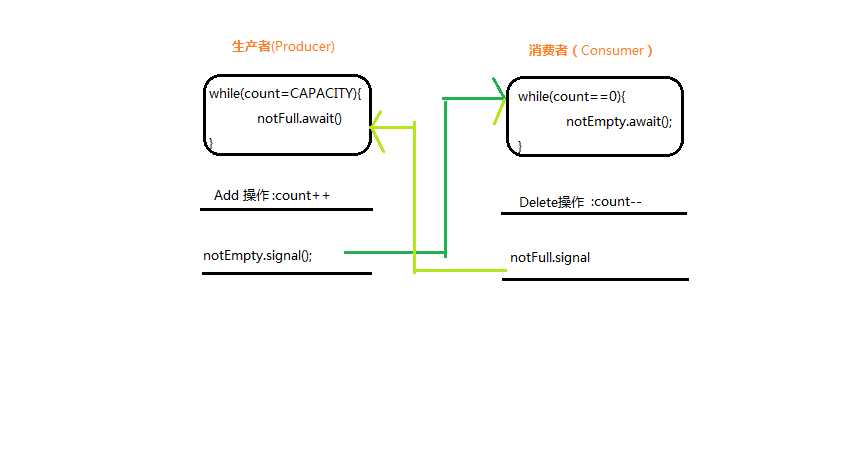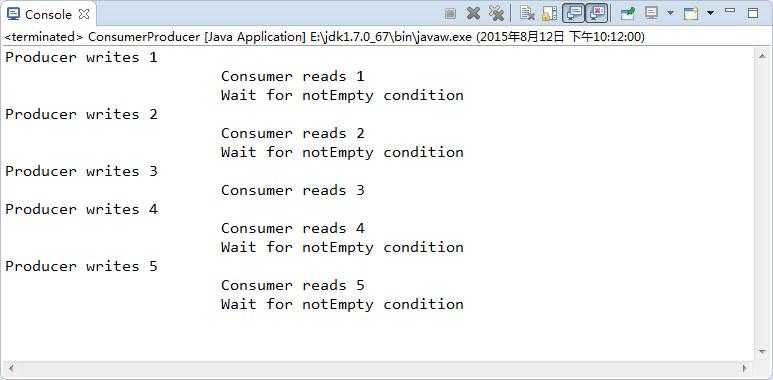标签:
前言:
前面因时间关系,未将“生产者消费者问题”实例的介绍发布在博客随笔中,故本文作为对之前“多线程”一文的补充。
概念:
生产者消费者问题(Bounded-buffer problem),是一个多线程同步问题的经典案例。这个案例中主要实现的是两个角色协同对同一资源进行访问。生产者的主要作用是生成一定量的数据放到缓冲区中,然后重复此过程。与此同时,消费者也在缓冲区消耗这些数据。该问题的关键就是要保证生产者不会在缓冲区满时加入数据,消费者也不会在缓冲区中空时消耗数据。
设计:本博客前面关于多线程的文章中已讲述过一个实例。本文的思路跟之前差不多,不过这次引入了一个存储资源的队列,并且需要设定2个用于信号传递的条件(Condition)。其实现过程见如下简图:

代码实现:
package com.gdufe.thread.consumer;
import java.util.concurrent.ExecutorService;
import java.util.concurrent.Executors;
import java.util.concurrent.locks.Condition;
import java.util.concurrent.locks.Lock;
import java.util.concurrent.locks.ReentrantLock;
public class ConsumerProducer {
private static Buffer buffer = new Buffer();
public static void main(String[] args) {
// Create a thread pool with two threads
ExecutorService executor = Executors.newFixedThreadPool(2);
executor.execute(new ProducerTask());
executor.execute(new ConsumerTask());
executor.shutdown();
}
// A task for adding an int to the buffer
private static class ProducerTask implements Runnable {
public void run() {
try {
int i = 1;
while (true) {
System.out.println("Producer writes " + i);
buffer.write(i++); // Add a value to the buffer
// Put the thread into sleep
Thread.sleep((int)(Math.random() * 10000));
}
} catch (InterruptedException ex) {
ex.printStackTrace();
}
}
}
// A task for reading and deleting an int from the buffer
private static class ConsumerTask implements Runnable {
public void run() {
try {
while (true) {
System.out.println("\t\t\tConsumer reads " + buffer.read());
// Put the thread into sleep
Thread.sleep((int)(Math.random() * 10000));
}
} catch (InterruptedException ex) {
ex.printStackTrace();
}
}
}
// An inner class for buffer
private static class Buffer {
private static final int CAPACITY = 1; // buffer size
private java.util.LinkedList<Integer> queue =
new java.util.LinkedList<Integer>(); //queue for storing data
// Create a new lock
private static Lock lock = new ReentrantLock();
// Create two conditions
private static Condition notEmpty = lock.newCondition();
private static Condition notFull = lock.newCondition();
public void write(int value) {
lock.lock(); // Acquire the lock
try {
while (queue.size() == CAPACITY) {
System.out.println("Wait for notFull condition");
notFull.await();
}
queue.offer(value);
notEmpty.signal(); // Signal notEmpty condition
} catch (InterruptedException ex) {
ex.printStackTrace();
} finally {
lock.unlock(); // Release the lock
}
}
public int read() {
int value = 0;
lock.lock(); // Acquire the lock
try {
while (queue.isEmpty()) {
System.out.println("\t\t\tWait for notEmpty condition");
notEmpty.await();
}
value = queue.remove();
notFull.signal(); // Signal notFull condition
} catch (InterruptedException ex) {
ex.printStackTrace();
} finally {
lock.unlock(); // Release the lock
return value;
}
}
}
}
测试结果:

补充:
在Java集合框架中,其实有“阻塞队列”这一概念。其特点具有同步方法,也就是说套用阻塞队列,我们可以通过简化上面的代码同样实现生产者消费者的线程同步问题。
参考代码如下:
1 package com.gdufe.thread.consumer; 2 3 import java.util.concurrent.ArrayBlockingQueue; 4 import java.util.concurrent.ExecutorService; 5 import java.util.concurrent.Executors; 6 7 public class ConsumerProducerUsingBlockingQueue { 8 private static ArrayBlockingQueue<Integer> buffer = 9 new ArrayBlockingQueue<Integer>(2); 10 11 public static void main(String[] args) { 12 // Create a thread pool with two threads 13 ExecutorService executor = Executors.newFixedThreadPool(2); 14 executor.execute(new ProducerTask()); 15 executor.execute(new ConsumerTask()); 16 executor.shutdown(); 17 } 18 19 // A task for adding an int to the buffer 20 private static class ProducerTask implements Runnable { 21 public void run() { 22 try { 23 int i = 1; 24 while (true) { 25 System.out.println("Producer writes " + i); 26 buffer.put(i++); // Add any value to the buffer, say, 1 27 // Put the thread into sleep 28 Thread.sleep((int)(Math.random() * 10000)); 29 } 30 } catch (InterruptedException ex) { 31 ex.printStackTrace(); 32 } 33 } 34 } 35 36 // A task for reading and deleting an int from the buffer 37 private static class ConsumerTask implements Runnable { 38 public void run() { 39 try { 40 while (true) { 41 System.out.println("\t\t\tConsumer reads " + buffer.take()); 42 // Put the thread into sleep 43 Thread.sleep((int)(Math.random() * 10000)); 44 } 45 } catch (InterruptedException ex) { 46 ex.printStackTrace(); 47 } 48 } 49 } 50 }
标签:
原文地址:http://www.cnblogs.com/SeaSky0606/p/4725794.html